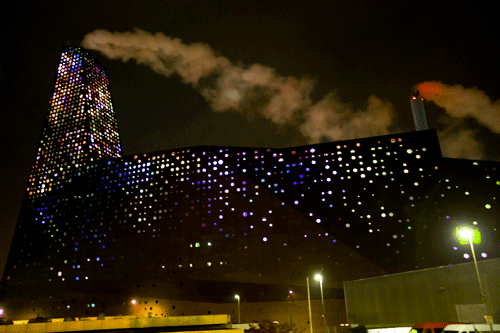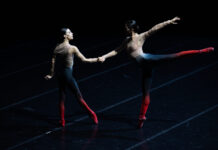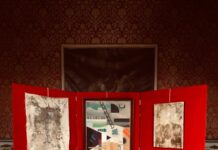It is not the only case in which the role of the work done with the students ofscenographyis highlighted. Specifically linked to teaching, for example, is the type of research to which the author has attributed the definition of ‘technical dramas’. These shows are performed without actors, mostly made as a result of laboratory activities, in traditional theatres, taking on stage devices and equipment as protagonists and subjects of poetic construction. Regarding them, we also encounter a revealing statement: “Perhaps it is precisely during the first workshops of the 1980s, held in a small Italian theatre, that the idea of theatre of places began to appear inside me[6].”
The actor, therefore, is a non-essential presence in Fabrizio Crisafulli’stheatre, representing a relative anomaly in the current Italian theatrical panorama. Yet, perhaps unexpectedly, some of the subtler observations are dedicated to actors. In fact, stripped of every authoritarian aspect, the director’s work turns into a sort of maieutic aimed at stimulating the creative condition in the performer. “Through my proposals” he writes “I try to induce everyone to find their own way […] to encourage an open, receptive disposition in the group, aimed at listening. I try to facilitate solutions for supportive, silent, meditative work, paying attention to spaces, things, noises and footsteps, without being worried about finding immediate solutions”[7].
And so, the director identifies with one who proposes relationships, and does not impose solutions. On the other hand, the actormust draw on a state in which the apparently antithetical attitudes of “abandonment” and “vigilance”, of passivity and activity coexist. “At the basis of this theory there is also the idea […] that, in order to be able to do on stage, you must first be able not to do; and in order to speak you must first have the ability not to speak. Having the ability to be present at the place. To be on the spot. And it concerns the belief that the spheres of listening, observation and waiting are not, for the actor, less important than those of the word, initiative and action. And that these skills are indeed constitutive and complementary”[8].
There are, therefore two key notions in Crisafulli’s work: listening and relationship. These are the terms he uses most frequently in his description of the procedures and operating methods of the ‘Teatro dei Luoghi’. The place is a living fabric of memories, stories and relationships. The place must be inhabited and listened to. The place is a reality with its own identity with which it is necessary to relate and which plays a generative role with respect to creation: “In the preparatory work a central function is always carried out by listening, by the willingness to be in place, observing it and inhabiting it for a long time. And, as regards to the relationship with objects and architectures, also by the attitude to give to the inorganic sphere equal weight than to the organic one; to the inanimate the same importance as to the animate. It meansto pay attention to ‘things’, as elements with their own life. They are considered, therefore, not as simple values of use, entities to be ‘manipulated’, ‘set up’, subjected to work, to be taken as ‘accessories’ or background elements of the show, but as sensitive realities, to be ‘made’ in the work with their autonomy and their ‘soul’[9].

It is an interesting statement, not only because it exemplifies the qualities of receptivity and sensitivity,whichpersists in this type of work, but also because it evokes the tension towards a subtle and ineffable dimension; something like a anima mundi, which must be intercepted and revealed, without spiritualistic pleasure and without giving up a strong ironic charge.
This type of setting is due to an uninterrupted production of theatrical work and installation. We need only recall some of his latest stage productions. First, Die Schlafenden (2013), created at Maria Saal’s Tonhof in Austria, the historical place of the Austrian literary and artistic avant-garde, inspired by the novel The House of Sleeping Beauty by Yasunari Kawabata[10]. I would still like to recall the most recent performance Corpoluce(2019), conceived together with the dancer Alessandra Cristiani, focused on the relationship between the dancing body and the subtle luminous lines that make up and break down in space[11]. In the field of installations, Crisafulli creates imaginative works such as Impulse (2016). This piece gave birth, through light, to the remarkable architecture of the Energy Tower, a large waste-to-energy incinerator near Copenhagen[12]. Inhabitants(2018), occupied a room in MACRO, Rome, for a month, with a relational project in which numerous artists took part[13]. In 2019 he created Figur’azioni, at the Cistercian Abbey of Fossanova. The front was acted out by video-projected female silhouettes. Proiectumwas realisedthe same year at the Vallicelliana Library in Rome.The work is dedicated to Francesco Borromini and in collaboration with the artist Federica Luzzi.
In his writings, the artist often speaks of meditation and energies. He said, among other things: “Attempting to touch the essence of a site and its spirit […] also means trying to put the powers of the place to work. In this attempt to grasp the innermost core, perhaps lies the sense of “sacredness” that often […] the public feels in these works “. Perhaps, one of the reasons for the charm and fortune of Fabrizio Crisafulli’stheatre also lies in the thirst for sacredness widespread in our era.







